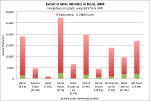Less than 200 blond capuchins (Cebus falvius) survive in the highly-fragmented habitat of Brazil’s Atlantic Forest. But this tiny group of monkeys, only rediscovered in 2006, is surprising scientists with its adept tool-using abilities. Displaying similar behavior to that which made the chimpanzees of Gombe famous worldwide, the blond capuchins modify sticks to gather termites from trees; however, according to the study published in Biology Letters the blond capuchins use two techniques never witnessed before: twisting the stick when inside the termite nest and tapping the nest before inserting the stick.
“Tapping the walls of the nest and rotating the stick have not been reported previously for chimpanzees or any other non-human primates. They indicate effective problem solving and effective deployment of sensitive manual actions,” the study’s authors write.
The technique of rotating the stick and tapping the nest add to the monkey’s success according to researchers, who tested the monkeys’ techniques for themselves.
“It really worked. The way they do it really enhanced their catch,” lead author Antonio Souto of the Universidade Federal de Pernambuco, Brazil, told LiveScience. “I think they can do better than we did; they have more experience.”
In addition, this is the first time capuchin monkeys have been observed using tools above the ground, since they raid termite nests on tree trunks.
First described by German naturalist George Marcgrave in 1664, the blond capuchin was formally named in 1774. But the blond capuchin disappeared for centuries, only to be re-discovered in 2006. The remaining populations is threatened by habitat loss, as well as hunting for food and as pets. Researchers estimate that 180 survive.
CITATION: Antonio Souto, Camila B. C. Bione, Monique Bastos, Bruna M. Bezerra, Dorothy Fragaszy and Nicola Schiel.
Critically endangered blonde capuchins fish for termites and use new techniques to accomplish the task. Biology Letters. doi: 10.1098/rsbl.2011.0034.
Related articles
Working to save the ‘living dead’ in the Atlantic Forest, an interview with Antonio Rossano Mendes Pontes

(09/23/2009) The Atlantic Forest may very well be the most imperiled tropical ecosystem in the world: it is estimated that seven percent (or less) of the original forest remains. Lining the coast of Brazil, what is left of the forest is largely patches and fragments that are hemmed in by metropolises and monocultures. Yet, some areas are worse than others, such as the Pernambuco Endemism Centre, a region in the northeast that has largely been ignored by scientists and conservation efforts. Here, 98 percent of the forest is gone, and 70 percent of what remains are patches measuring less than 10 hectares. Due to this fragmentation all large mammals have gone regionally extinct and the small mammals are described by Antonio Rossano Mendes Pontes, a professor and researcher at the Federal University of Pernambuco, as the ‘living dead’.
Destruction of Brazil’s most imperiled rainforest continues

(05/31/2009) More than 100,000 hectares of Brazil’s most threatened ecosystem was cleared between 2005 and 2008, reports a study by the Fundação SOS Mata Atlãntica and the National Institute for Space Research (INPE). The “Atlas of Mata Atlântica Remnants”, released May 26, assessed the extent of the Mata Atlântica (Atlantic Forest) across 10 of the 17 states where the coastal rainforest occurs. It found that an 102,938 hectares were destroyed during the three year period. The annual loss of 34,121 hectares per year was 2.4 percent lower than the 34,965 ha recorded from the 2000-2005 period.

(01/10/2008) The Atlantic forest of Brazil boasts South America’s largest primates, the Southern and Northern Muriqui. The muriqui are unique among all primates, because they are not territorial and do not display aggressive behvaior. The IUCN has classified the Southern Muriqui as endangered, while the Nothern Muriqui is critically endangered. Dr. Karen Strier has studied the Northern Muriqui in the field for twenty-five years. A professor of zoology and anthropology at the University of Madison Wisconsin, she is the author of Faces in the Forest: the Endangered Muriqui Monkeys of Brazil and a new textbook entitled Primate behvaioral Ecology.